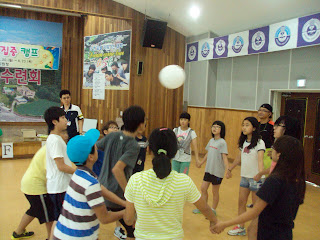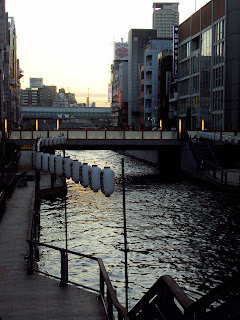First up was exploring the city of Osaka. We stayed at Ten Hostel, a great urban-inspired hostel with traditional ondol rooms. (Basically a futon mattress, blankets and pillows.) The hostel staff couldn't have been more helpful. Definitely recommend it to anyone traveling within Osaka. (http://ten.hostelosaka.com/rooms_en.html)
It was a relaxed day, taking in the city. We had Udon noodles for dinner then walked over to Umeda for some drinks.


Nara. The next day we braved the subway system to Nara (which by the way, sucks compared to the Korean subway. So confusing. But thanks to the recommendation from a few friends in Korea, we purchased the Kansai Train Pass, which helped a ton in getting around.) We fed wild deer, saw many temples and pagodas including the famous Five-Storied Pagoda and Todai-ji Temple, (the largest wooden building in the world) which holds The Great Buddha Vairocana (the largest bronze Buddha in the world.) I don't have the words to express how enormous this statue was, and of course pictures never do justice. Like many temples, it took a while to get to the actual temple, first going through the outskirts of it. The second I walked into the building, my feet stood still, mesmerized by the size of it. You don't have to be Buddhist to feel the emotion that comes along with being in the presence of this religious figure standing so beautiful and so much larger than life. For lunch, we had okonomiyaki, a Japanese favorite. It's like a big grilled pancake made up of cuttlefish, onions, cabbage, cheese, egg, seaweed, ginger, and other vegetables. Delicious.

 |
| The Five-Storied Pagoda |
 |
| Cleansing at the entrance to a temple |
 |
| The Five-Storied Pagoda |
 |
| okonomiyaki |
 |
| Todai-ji Temple |
 |
| Buddha Vairocana |
 |
| Looking up at the Buddha |
Kyoto. The next day we made our way to the former imperial capital of Japan, Kyoto. This place is filled with culture, including a total of 1600 Buddhist temples and 400 Shinto shrines. One of our first stops was Kiyomizu-dera, a temple built on a mountainside, overlooking Eastern Kyoto. It was quite a hike walking up to it, but boy was it worth it. We also made it to the district of Arashiyama, including Sagano Bamboo Forest. The forest was a nice peaceful getaway from everything, and was the perfect opportunity to take a bunch of artsy photos. We ended up in the Gion District (the Geisha District) for dinner and some shopping. There, we saw many Japanese women dressed up in traditional kimonos, hired to appear as real geishas. It reminded me of Disney characters in Disney. The real geishas are a part of a kind of underground world, not for show to the public. In Kyoto, we had more okonomiyaki as well as horai, a famous hot meat bun (I opted for a tofu one). Again, delicious.
 |
| okonomiyaki |
 |
| Kiyomizu-dera |
 |
| horai |
 |
| prayer sticks |
We had one last full day in Japan, and we decided to relax and take in the modern culture of Osaka. We made our way down to Namba, exploring Shinsaibashi (the shopping district) and Dotonbori (also known for its many restaurants and shopping) We visited American Town, where I went into my first Uniqlo, which I'm now obsessed with, by the way.
 |
| America town |
Side note- this needs it's own paragraph.
One word: Takoyaki.
This is an Osaka favorite. A few friends in Korea basically told me I couldn't leave Osaka without trying it, and so finally in Dotonbori, we stopped in what looked like one of the most popular takoyaki restaurants, (all we had to do was look at the long line of people). You're probably wondering what it is huh? Well, takoyaki is simply an octopus filled pastry ball. It includes ginger, tempura, green onion and is mixed with a type of Bisquick looking batter, and made in a special takoyaki pan. They top it with a drizzle of takoyaki sauce and Japanese mayonnaise, and a sprinkle of extra ginger. It's a famous Osaka street food, and you can find them almost everywhere you turn. However, we were able to sit down at this restaurant and enjoy it. WOW. I can't say enough about it. Definitely a must for anyone going to Osaka.
 |
| The restaurant where we ate |
 |
making takoyaki
 |
| finished product |
|
That night, we stayed at Capsule Hotel Asahiplaza Shinsaibashi. (http://www.asahiplaza.co.jp/capcel/english.html) It was closer to the airport, for we both had early flights, and it was something we both were interested in experiencing. Men and women are separated by floors, and you need a key to enter everything. It includes public baths called onsen, saunas, and massage rooms. Your capsule room is small enough to fit just your bed and nothing else. It's very hard to explain, for we have nothing to compare it to in the States as far as I know, so the photos can do that for me. But I did experience my first public bath. Talk about having to be comfortable with your body. I have recently gone to my first jimjilbang, which I will have to devote an entire post to soon.
Now, for only having 5 total days in Japan, including travel time, we saw and did A LOT. I'm kind of surprised at how much we accomplished, despite the insane heat. It was unbearable at times, but I'm glad we fought through the sweat and were able to experience and see what we wanted to. What I've realized about my traveling is that people differ greatly when they travel. Half of us travel to these culture rich areas in hopes to see the temples, and the traditional side of the country, taking in the history and culture. And the other half go with the mindset of laying on a beach somewhere drinking pina coladas and shopping. For me, I've learned that I like a nice mix. I love seeing these beautiful pagodas, temples, and sculptures. I picture what it must have been like during the time they were first built, how different life was. Though those times live forever in our textbooks and in movies, our world is changing every day. And so as much as I like to bow to Buddha, and wash my hands with its holy water, I also enjoy sitting at a Starbucks and taking in modern-day Japan and its people.
What I found most interesting was finding myself comparing the Japanese to Koreans and not to Americans. Korea really has become my home. I realized that a few days in, when I was picking up Korean language around me, only from a few exchanged words. Before I came to Korea, Asian language was all the same to me. I never had enough exposure to differentiate between, Mandarin, Japanese, Korean, Thai, etc. But sitting in Japan on a subway, I was able to point out the Koreans sitting amongst everyone by mere spoken words. I found that so cool. Never would I think I'd be able to do that.
I also noticed how Japanese fashion differs from Korean. Koreans are very conservative, as I've spoken about in multiple posts. But in Japan, I felt like the sky was the limit. Anything goes. I understand I was in Osaka, which is a big party city, but even in culture-rich areas like Kyoto, I noticed it as well. Girls were not covering up top like Koreans do. Japanese men had more liberal haircuts, some wearing spiky gelled-up hair, paired with black clothing. Most Korean men are pretty men, always looking put together with their clean cut demeanor. In Osaka, you also got the very VERY openly advertised strip joints, where girls would stand outside their respective clubs with their "pimps" advertising them. You don't see anything like that in Korea. The business men type noraebangs and coffee shops in Korea where girls are hired to entertain the men are very much underground. It's one of those things that everyone knows about but is rarely talked about, and very frowned upon. Where in Japan, it's no surprise.
I found it interesting and humbling that on my flight back from Japan, I couldn't wait to get back home. I wanted my apartment, I missed my students, I missed being able to communicate. Bahaha that was the most comical, because I am in no way fluent in Korean, but when in Japan, I couldn't get out expressions like, "one moment please", "how much is this?", "beautiful!" "this tastes delicious," etc. But I knew how to say all of that in Korean and that was comforting once I made it back. When I landed in Busan, I felt I was home and secure. I was more at ease. Six months learning, living, and teaching in Korea did that. I have six months left. Half of my time here is over. Who knows where I will be in February.. but I do know that I am looking forward to each and every moment.































































